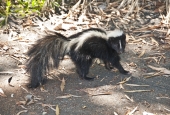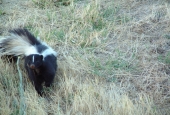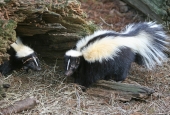Two species of skunks are found in Alameda County: the striped skunk and the rarer spotted skunk. The striped skunk (Mephitis mephitis) is more common and is about the size of a cat, 2-3 feet long and weighing 10-15 pounds. The fur is very thick and mostly black with a white stripe on its neck and head extending down the back and through the bushy tail. Sometimes the striping is hard to detect in the striped skunk. The spotted skunk (Spilogale gracilis) is a much smaller skunk, only half the size of the striped skunk and is very rare in Alameda County. Instead of stripes, the spotted skunk has white spots.
Skunks are nocturnal, coming out at night to forage for food. They are omnivorous and will eat almost anything. They consume fallen fruit from trees and will dig up the turf and gardens in search of insects and grubs. Skunks will also eat small rodents, pet and bird food left outdoors, frogs in ponds, mushrooms, and eggs from ground nesting birds.
Mating occurs in late December through February and young are born in March and April. Female skunks will typically have only one liter a year with 4 to 6 young (kits). Adult skunks can survive for 10 years.
Skunks are not climbers. They prefer to live under a home or a crawl space, under a backyard deck, or porch. In the wild, skunks search for other animal’s dens or burrows, or establish their nest in a hollow log or culvert.
In Alameda County,
bats and skunks are the two animals that can carry rabies. The rabies virus (Lyssavirus) is nearly always fatal when not treated with the appropriate prophylaxis. The virus is found in the saliva of a rabid skunk and transmitted through their bite or scratch. There are two variants of the rabies virus (bat and skunk) found in California but all mammals are susceptible. The incubation period is highly variable, but usually lasts 3-8 weeks.
Skunks are also carriers of other diseases including leptospirosis, listeriosis, canine distemper, canine hepatitis, Q-fever, tularemia, and trypanosomyiasis.
During the mating season, it is not uncommon for males to attempt to mate with females in the crawl spaces under homes. During the mating process the skunks may spray their potent and pungent liquid under the house, causing severe discomfort to the residents. In addition, skunk spray is of public health significance because it is acrid enough to cause nausea, severe burning, or even temporary blindness if it contacts the eyes.
If resident is experiencing problems with skunks it is strongly recommended that they call the district so that a Vector Control Biologist can conduct an investigation. The Vector Control Biologist will determine what prevention and exclusion methods would be most successful in removing the skunks from the property.






